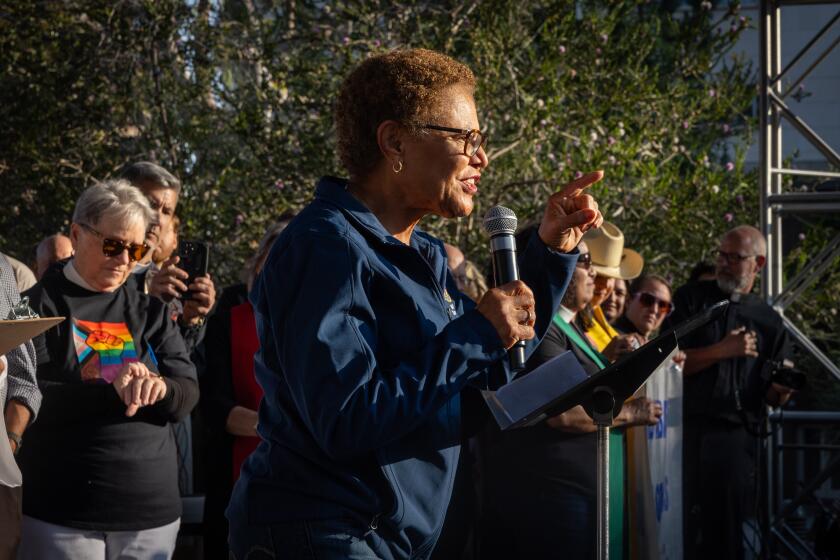Ventura Boulevard Plan Changes Studied
- Share via
Proposed changes to the Ventura Boulevard Specific Plan will be considered by the Los Angeles Planning Commission at its meeting at the Sportsmen’s Lodge in Studio City on Wednesday.
The changes--proposed by the Los Angeles city planning and transportation departments--would cut in half fees paid by new developers and reduce the budget for boulevard improvements from $222 million to $77 million. The improvements include intersection widenings, more parking and additional landscaping along the 17-mile commercial strip that traverses the San Fernando Valley.
The city departments want to reduce the plan’s budget and the developer fees that finance it for a few reasons. First, they want to correct an arithmetic error that inflated costs by $73.6 million. Second, lower growth projections along the strip mean fewer improvements will be needed. And finally, they want to make the developer fees, which offset the negative impact of a project, more equitable.
At its Dec. 8 meeting, the Planning Commission decided to put off action on the proposed plan amendments until next week’s meeting at the request of community leaders who said they needed more time and information to evaluate the proposed changes.
The panel also asked city staff to hold a community workshop to gather public opinion on a broader question: Should Ventura Boulevard be a major transportation artery or a pedestrian-oriented shopping street?
About 40 community activists, business leaders and homeowners from Woodland Hills to Studio City attended the Jan. 6 workshop in Sherman Oaks, where they debated the advisability of intersection widenings--the adding of turn lanes to improve traffic flow--and benefit assessment districts to pay for street beautification.
The Feb. 9 meeting will begin at 9:30 a.m.
(BEGIN TEXT OF INFOBOX / INFOGRAPHIC)
Topanga Canyon Boulevard Repairs
For nearly three weeks workers have toiled day and night to repair two areas of flood-damaged road on Topanga Canyon Boulevard. At least five other sites along the road also suffered minor damage. Heavy rains turned normally placid Topanga Creek and other canyon streams into raging torrents that eroded embankments and undermined the boulevard. Road closures due to the construction frustrated motorists using the major canyon thoroughfare between the San Fernando Valley and Pacific Coast Highway. Normally, about 14,000 drivers a day use the road, which Caltrans is planning to reopen this weekend. The methods used to reconstruct the washed-out portions of road are commonly used in steep canyons.
Grand View Drive Site
A blocked culvert across from the site caused water to wash over the street, creating a 30-foot-deep hole and collapsing most of the northbound lane. To support a wall, concrete blocks were stacked and the spaces between them, were filled with a combination of stones and sand. More than 50 workers placed the blocks by hand, and a compactor was used to press the fill in place. The roadway above the wall was then paved and concrete barriers installed.
*
Wall was built at an angle to prevent it from sliding or overturning.
Filter rock allows water to seep into drainage pipe and deposit into stream.
Compacted fill material
Packed native material
Filter rocks allows water to seep into drainage pipe and deposit into stream.
Each concrete block measures about 4 feet by 6 inches and is reinforced with metal rebar.
A hand- held compactor was used to firm the 5,000 cubic yards of fill and pack it between the blocks.
Each concrete block measures about 4 feet by 6 inches and is reinforced with metal rebar.
Site South of S Curves
At a second site, large boulders were used to shore up the embankment. Crews first excavated loose rock and other material down to bedrock, filling the space with boulders to create a new creek bank. Earthmovers created a barrier out of rocks, temporarily diverting Topanga Creek. The eroded hillside was covered from the bottom up with layers of packed native earth, crushed filter rock and large granite boulders. Cement was poured over and between boulders, securing them to the hillside.
About 5,000 tons of rock were brought in to reinforce the slope.
Fill material
Packed native material
Filter rock
Cement is poured over and between rocks, securing the slope.
A temporary rock barrier diverts the creek.
A trench carved in bedrock supports the reinforced bank.
Source: Caltrans; Researched by JULIE SHEER / Los Angeles Times
More to Read
Sign up for Essential California
The most important California stories and recommendations in your inbox every morning.
You may occasionally receive promotional content from the Los Angeles Times.













